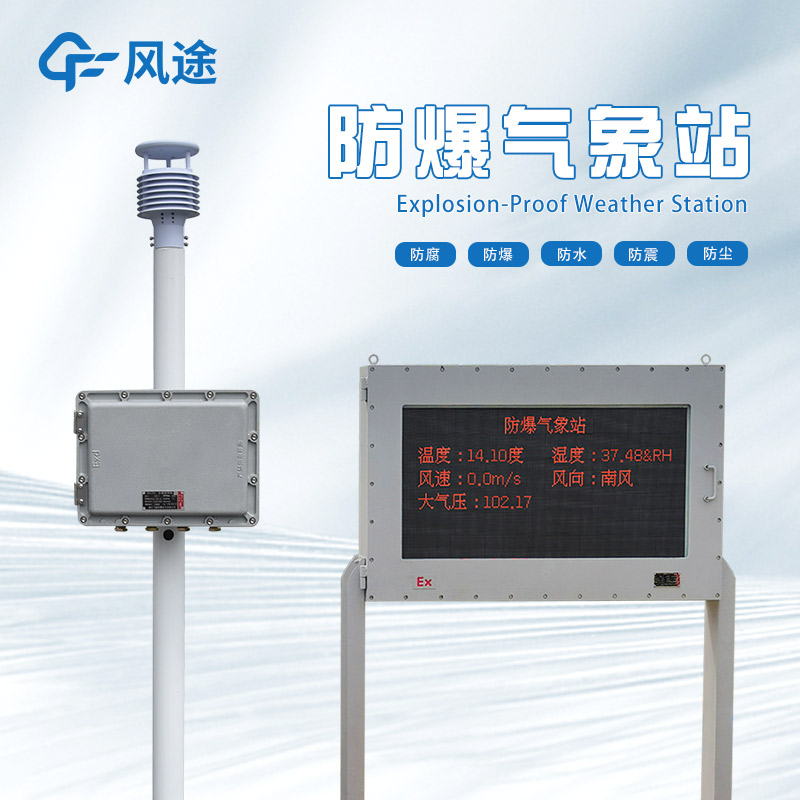Tianyi Sensor IOT Technology Co., Ltd
Sales Manager:Ms. Emily Wang
Cel,Whatsapp,Wechat:+86 15898932201
Email:info@fengtutec.com
Add:No. 155 Optoelectronic Industry Accelerator, Gaoxin District, Weifang, Shandong, China

Sales Manager:Ms. Emily Wang
Cel,Whatsapp,Wechat:+86 15898932201
Email:info@fengtutec.com
Add:No. 155 Optoelectronic Industry Accelerator, Gaoxin District, Weifang, Shandong, China
time:2025-03-06 09:59:28 source:Weather Station viewed:199 time
Explosion - proof weather stations are meteorological monitoring devices specifically designed to operate in hazardous environments. With the development of industries such as manufacturing, military, and chemical, the demand for explosion - proof weather stations has been growing steadily. The main function of an explosion - proof weather station is to monitor and record in real - time the changes in meteorological elements such as atmospheric temperature, humidity, air pressure, wind direction, and wind speed, providing accurate and reliable meteorological data support for relevant industries. By adopting explosion - proof technologies, explosion - proof weather stations can operate normally in potentially dangerous areas, ensuring the safety of workers' lives and property.
Based on the scale of the factory and the distribution of production areas, explosion - proof weather stations are installed respectively upwind and downwind of the factory, near key production workshops, around warehouses, and in areas with high and low terrain prone to waterlogging. For large - scale factories, a station is set up at intervals of a certain distance (such as 500 meters) to ensure full coverage of the factory area and accurately capture meteorological changes at different locations.
Explosion - proof weather stations send the collected real - time meteorological data to the monitoring server within the factory through wireless transmission modules (such as GPRS or 4G). The server is installed with professional data - processing software that parses, stores, and analyzes the received data. The software can conduct statistical analysis on historical data, draw curves of changes in meteorological elements, and predict meteorological trends. At the same time, it can automatically trigger warning messages according to preset meteorological thresholds.
A multi - level warning mechanism is established based on the weather stations. For example, when meteorological parameters reach the first - level warning threshold (such as wind speed exceeding 10m/s, rainfall exceeding 10mm/h, air pressure lower than 980hPa, etc., values that may affect production safety), the system sends warning messages to the factory's safety management department, heads of production departments, and relevant staff through various means such as text messages, audible and visual alarms, and the factory's internal instant messaging software, reminding them to take protective measures. When the second - level warning threshold is reached (more severe weather conditions, such as wind speed exceeding 15m/s, rainfall exceeding 20mm/h, etc.), in addition to the above warning methods, the factory's corresponding emergency plans are automatically activated, such as suspending some outdoor operations and strengthening equipment protection.

Negative oxygen ion monitoring plays a crucial role in ecological environment research and air quality management. Negative oxygen ions are negatively charged ions in the air, which are widely distributed in the natural environment. Their concentration levels are closely related to air quality. High...
You may not know that the occurrence and spread of many plant diseases are related to pathogenic spores. Spores are the reproductive units of fungal pathogens, which are tiny in size and numerous in quantity. They can be widely transmitted through media such as wind, rain, and insects. Once spores l...
Ports serve as critical hubs connecting the ocean and land, with numerous vessels entering/exiting and cargo being loaded/unloaded daily. However, due to their unique geographic locations, ports face complex and variable meteorological conditions. Among these, wind speed and direction significantly...
In transportation, high-speed railways and road transport are significantly affected by meteorological conditions. In severe weather such as heavy rain, snowstorms, heavy fog, or strong winds, road surfaces become slippery, visibility drops sharply, and high-speed railway tracks may even freeze. All...